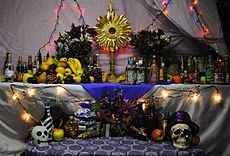Folk Catholicism
Folk Catholicism can be broadly described as any of various ethnic expressions of Catholicism as practiced in Catholic communities. Practices identified by outside observers as folk Catholicism vary from place to place and may sometimes contradict the official teachings and practices of the Roman Catholic Church. In general, when aspects of folk religion intermingle with Catholic beliefs in an area, folk Catholicism will result.[1]

Description
Some forms of folk Catholic practices are based on syncretism with non-Catholic beliefs. Some of these folk Catholic forms have come to be identified as separate religions, as is the case with Caribbean and Brazilian syncretisms between Catholicism and West African religions, which include Haitian Vodou, Cuban Santería, and Brazilian Candomblé.
Similarly complex syncretisms between Catholic practice and indigenous or Native American belief systems, as are common in Maya communities of Guatemala and Quechua communities of Peru to give just two examples, are typically not named as separate religions; their practitioners generally regard themselves as good Catholics even while worshiping non-Christian gods.
Other folk Catholic practices are local elaborations of Catholic custom which do not contradict Catholic doctrine and practice. Examples include compadrazgo in modern Iberia, Latin America and the Philippines, which developed from standard medieval European Catholic practices that fell out of favor in Europe after the seventeenth century; the veneration of some local saints, and pilgrimages in medieval and modern Europe. Folk Catholic practices occur where Catholicism is a major religion, not only in the often-cited cases of Latin America and the West Indies. Folk accommodations between Catholicism and local beliefs can be found in Gaelic Scotland, the Philippines, Ireland, Spain, Portugal, France, Italy, Poland, and southern India.
In Ireland openly Catholic worship was banned due to the Penal Laws. This led to storytellers inventing their owns tales so as to teach the Gospel or add further lessons. These further lessons however often end up contradicting the teaching of the Catholic Church. Within these stories a variety of recurring characters and themes appear such as the Virgin Mary, priests, Paul the Apostle, Satan and Jesus himself.[2]
In the Philippines, the custom of Simbang Gabi developed from the farming community.[3] Simbang Gabi is a devotional nine-day series of Masses leading up to Christmas. On the last day of the Simbang Gabi, which is Christmas Eve, the service is instead called Misa de Gallo (Spanish for "Rooster's Mass"). It has an important role in Philippine culture. It has its origins in the early days of Spanish rule over the Philippines as a practical compromise for farmers, who began work before sunrise to avoid the noonday heat out in the fields. Despite being exhausted by a long day's labor, the people would still attend the customary evening novenas. In 1669, the priests began to say Mass in the early mornings instead of the evening novenas more common in the rest of the Hispanic world. This cherished Christmas custom eventually became a distinct feature of Philippine culture and became a symbol of sharing.[4]
The Roman Catholic Church takes a pragmatic and patient stance towards folk Catholicism. For example, it may permit pilgrimages to the site of reported apparitions (e.g. Međugorje) without endorsing or condemning belief in the reported apparitions, and will often declare Marian apparitions and similar miracles "worthy of belief" (e.g. Our Lady of Fatima), or will confirm the cult of local saints without actually endorsing or recommending belief. When the Roman Catholic church considers that there is a blatant heresy occurring, it actively rejects it and tells Catholics to stay away from such practices. This is the case of the cult of Santa Muerte (Saint Death, a personification and worshiping of death). The church has condemned the cult as blasphemous, calling it a "degeneration of religion".[5][6][7]
See also
- Folk Orthodoxy - an Eastern Orthodox equivalent
- Lucban#Pahiyas Festival
- Popular piety
References
Footnotes
- Vergote 1982.
- O Suilleabhain, Sean (2011). Miraculous Plenty: Irish Religious Folktales and Legends. University College Dublin. pp. 17–21. ISBN 978-0-9565628-2-1.
- Ordonez, Minyong. "Why folk Catholicism keeps our faith alive", Philippine Daily Inquirer, March 11, 2012
- Roces, Alfredo (1 October 2009). Culture Shock! Philippines: A Survival Guide to Customs and Etiquette. Marshall Cavendish Reference. ISBN 978-0761456711.
- "'Saint Death' Comes to Chicago". Chicago Tribune. Retrieved 8 September 2016.
- Garma, Carlos (10 April 2009). "El culto a la Santa Muerte". El Universal (in Spanish). Mexico City. Retrieved 8 September 2016.
- "Vatican Declares Mexican Death Saint Blasphemous". BBC News. 9 May 2013. Retrieved 8 September 2016.
Bibliography
- Allen, Catherine (1999). The Hold Life Has: Coca and Cultural Identity in an Andean Community. Washington, DC: Smithsonian Institution Press.CS1 maint: ref=harv (link)
- Badone, Ellen, ed. (1990). Religious Orthodoxy and Popular Faith in European Society. Princeton, NJ: Princeton University Press.CS1 maint: ref=harv (link)
- Christian, William A., Jr. (1981). Apparitions in Late Medieval and Renaissance Spain. Princeton, NJ: Princeton University Press.CS1 maint: ref=harv (link)
- Johnson, Paul Christopher (2002). Secrets, Gossip, and Gods: The Transformation of Brazilian Candomblé. Oxford: Oxford University Press.CS1 maint: ref=harv (link)
- Nutini, Hugo (1984). Ritual Kinship: Ideological and Structural Integration of the Compadrazgo System in Rural Tlaxcala. Princeton, NJ: Princeton University Press.CS1 maint: ref=harv (link)
- ——— (1988). Todos Santos in Rural Tlaxcala: A Syncretic, Expressive, and Symbolic Analysis of the Cult of the Dead. Princeton, NJ: Princeton University Press.CS1 maint: ref=harv (link)
- Taylor, Lawrence J. (1995). Occasions of Faith: An Anthropology of Irish Catholics. Philadelphia: University of Pennsylvania Press.CS1 maint: ref=harv (link)
- Reyes, Dominic; et al. (2013). Folk Catholicism in Iligan City. Iligan, Philippines: MSU-Iligan Institute of Technology.CS1 maint: ref=harv (link)
- Vergote, Antoine (1982). "Folk Catholicism: Its Significance, Value and Ambiguities". Philippine Studies. 30 (1): 5–26. ISSN 2244-1638. JSTOR 42632594. Retrieved 21 July 2018.CS1 maint: ref=harv (link)